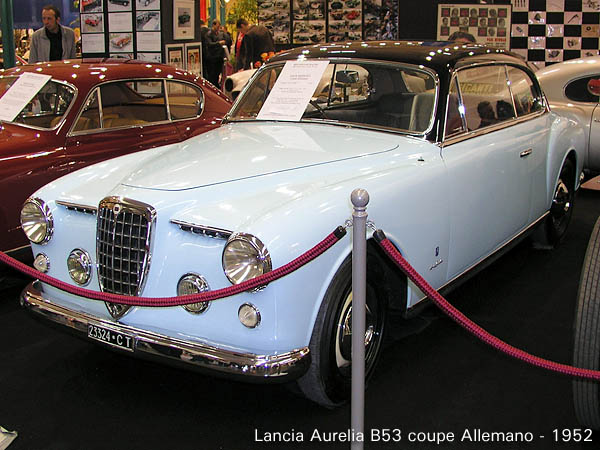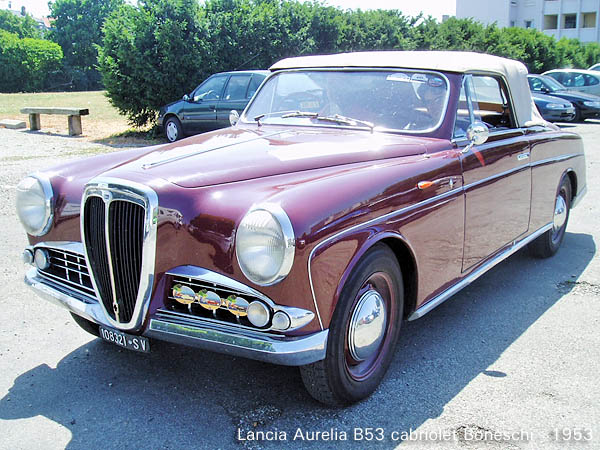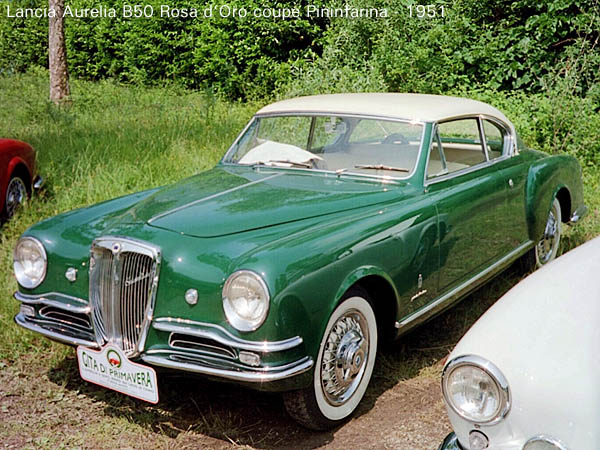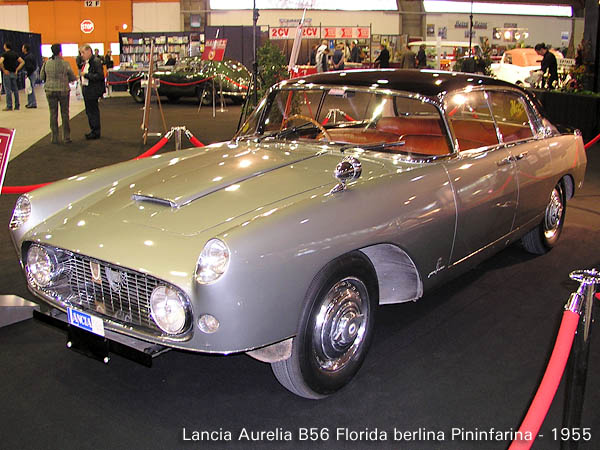 Carrozzeria Allemano was an established coachbuilder since 1928 but, like Vignale and others, used the skills of Michelotti to design special bodywork. The coupe shown here was specially made for the 1953 Turin Motor Show and remained a one-off. It's a pleasantly lined 4-seater with a more conservative look than Lancia's own GT. In front it has two distinctive air intakes between the grill and the headlights.
Carrozzeria Allemano was an established coachbuilder since 1928 but, like Vignale and others, used the skills of Michelotti to design special bodywork. The coupe shown here was specially made for the 1953 Turin Motor Show and remained a one-off. It's a pleasantly lined 4-seater with a more conservative look than Lancia's own GT. In front it has two distinctive air intakes between the grill and the headlights.
Few Aurelia chassis were fitted with Allemano bodies. Also the B53 chassis on which this car was built wasn't very popular; only 85 of these chassis were made. Like the B52 chassis (97 made), the B53 had the 1991 cc V6 engine with 70 hp @ 4800 rpm. Both the Aurelia B52 and B53 chassis were made from 1952 till 1953.
 For the early 1950s this was a very advanced body design. It preceded the squarish pontoon-style shapes which became popular in the 1960s and has done away with the vestigial separate front or rear wings which were still popular by then.
For the early 1950s this was a very advanced body design. It preceded the squarish pontoon-style shapes which became popular in the 1960s and has done away with the vestigial separate front or rear wings which were still popular by then.
This body was made by Carrozzeria Boneschi, one of the smaller, less known Italian coachbuilders. From the start in 1919 Boneschi made bodies for all sorts of chassis, also from other European countries. Its creations were mostly based on Lancia and Alfa Romeo platforms however. In fact, Giovanni Boneschi started his coachworks to provide Lancia with special versions of the Lambda. Near the end of the 1950s Boneschi stopped manufacturing bodies for passenger cars.
Boneschi made a number of designs for the Aurelia platform, very different from one another in style and appearance. It seems that none of these were made more than once or twice, so the actual production of Boneschi bodied Aurelias was very limited.
(picture by Jelle Peters, used with permission)
 Apart from the 4-seater cabriolet Pininfarina also made a varied collection of coachwork on the Aurelia chassis. There were streamlined sportscar models, open 2-seaters, coupes and special berlinas. A famous Pininfarina coupe on early Aurelia platforms is the Rosa d'Oro ("golden rose") model.
Apart from the 4-seater cabriolet Pininfarina also made a varied collection of coachwork on the Aurelia chassis. There were streamlined sportscar models, open 2-seaters, coupes and special berlinas. A famous Pininfarina coupe on early Aurelia platforms is the Rosa d'Oro ("golden rose") model.
This design was created in 1951 and displayed in 1952 at the Geneva Concours d'Elegance. It earned much appreciation for the way Pininfarina managed to conceal the long wheelbase of the Aurelia B50 platform and present a sporty and well-proportioned 2-door coupe on this base. Subsequently it was awarded first prize at the concourse, the golden rose, which rendered the car its name.
After the concourse the show car appeared on a number of events across Europe to attract publicity. Halfway 1952 the car was sold and two more were made to customer order. Two of these cars have survived to this day, the one shown here and a creamy white one with dark blue top.
(picture by Sébastien Simon, used with permission)
 One of the most imaginative series of special Aurelia designs by Pininfarina was the PF200 range. It had started as a study for an open sportscar with distinct jet fighter features, including a shiny round grill like an air intake in front, a flowing side profile and a rear with sharp fins. Later a coupe version followed with a cockpit-like cabin.
One of the most imaginative series of special Aurelia designs by Pininfarina was the PF200 range. It had started as a study for an open sportscar with distinct jet fighter features, including a shiny round grill like an air intake in front, a flowing side profile and a rear with sharp fins. Later a coupe version followed with a cockpit-like cabin.
Following the demand by customers for more practical versions of this design Pininfarina made a small series which included a 2-door convertible, a 2-door coupe and a 4-door sedan. Though still named PF200 these bodies were less extravagant and had a more traditional front end treatment. Only 2 cars of this series have survived to this day, and here you see a surviving 2-door coupe.
 Without a doubt the most famous and influential special on an Aurelia chassis was the Florida berlina by Pininfarina. It appeared in 1955 and four of them have been made, one 2-door and three 4-door sedans (like shown here).
Without a doubt the most famous and influential special on an Aurelia chassis was the Florida berlina by Pininfarina. It appeared in 1955 and four of them have been made, one 2-door and three 4-door sedans (like shown here).
The Florida berlina had a radical squarish design with a full width grill and decent tail fins. The spacious cabin featured large glass areas and a wrap-around panoramic windshield. Like the standard Aurelia the 4-door Florida special had pillarless, opposed opening doors. All bodies were painted in a tasteful 2-tone color scheme.
The modern pontoon-like looks of the Florida impressed and intrigued customers and car manufacturers alike. When Lancia came under new management in 1956 it was decided that the successor of the Aurelia should be based on the style and shape of the Florida show cars; this became the Lancia Flaminia berlina which was introduced in 1957. But it didn't stop there because other manufacturers contacted Pininfarina for similar sedan designs. This way models like the "Farina" saloons of BMC (Morris Oxford V, Austin A 55 Cambridge Mk II, Riley 4/68, Wolseley 15/60 and MG Magnette Mk III) of 1959, the Fiat 1800/2100/2300 berlinas of 1959 (a Mario Boano design under Pininfarina supervision) and the Peugeot 404 of 1960 came on the market. The new style of the Florida influenced European car design for decades to come and established Pininfarina as one of the most important styling studios.
Where the body of the Aurelia Florida started a trend, it also marked the end of the Aurelia and its rolling chassis. Very few of the B55 and B56 chassis were made: 14 and 5 from 1954 till 1955. These last versions of the chassis had the 2266 cc V6 engines with 87 hp @ 4800 rpm and the new De Dion style rear suspension.
There have been hundreds of more or less unique Aurelia specials made and this makes them very collectable. Few of these have made a lasting impression on car history but the fact that they were original designs and handcrafted combined with relatively modern automotive technology suited for every day use makes them sort of rolling sculptures. Expect them therefore to sell for art prices and not as obscure old cars. Unfortunately quite a number of cars on the Aurelia rolling chassis have not survived but virtually every barn and scrapyard in Italy is being searched for remnants of these cars as it can be very rewarding to restore and sell them.
